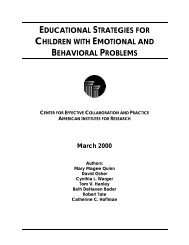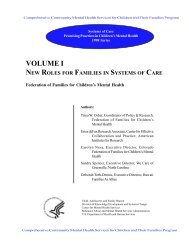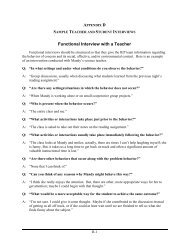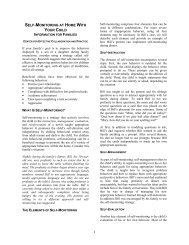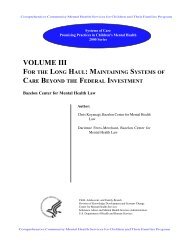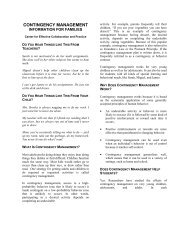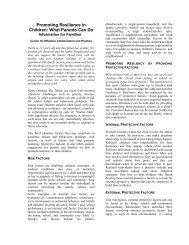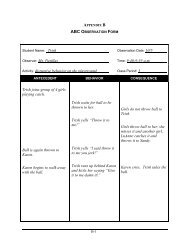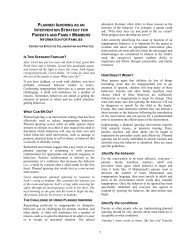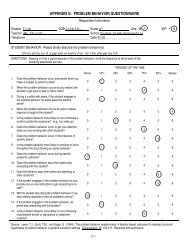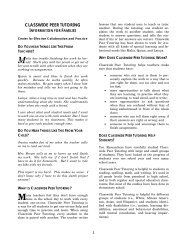Using evaluation data to manage, improve, market, and sustain ...
Using evaluation data to manage, improve, market, and sustain ...
Using evaluation data to manage, improve, market, and sustain ...
You also want an ePaper? Increase the reach of your titles
YUMPU automatically turns print PDFs into web optimized ePapers that Google loves.
Promising Practices in Children’s Mental Health<br />
Systems of Care - 2000 Series<br />
Evaluation reports need <strong>to</strong> be concise, easy <strong>to</strong> underst<strong>and</strong>, <strong>and</strong> tailored <strong>to</strong> the various needs of their<br />
audiences. But while the dem<strong>and</strong> for <strong>evaluation</strong> of programs <strong>and</strong> services in the private <strong>and</strong> public sec<strong>to</strong>rs<br />
has steadily increased, minimal resources have been designated <strong>to</strong>ward underst<strong>and</strong>ing what is involved in<br />
effective <strong>data</strong> reporting <strong>and</strong> presentation. The field of <strong>evaluation</strong> has been focused on implementing models<br />
of <strong>evaluation</strong>, but has omitted a pertinent question: “Given a program <strong>evaluation</strong> that has generated good<br />
<strong>data</strong>, what is the most effective strategy for <strong>data</strong> presentation <strong>and</strong> dissemination <strong>to</strong> advance stakeholder<br />
objectives?” Researcher <strong>and</strong> analyst Sharon Caudle recommends that evalua<strong>to</strong>rs “judiciously use text <strong>and</strong><br />
graphics, trend information, <strong>and</strong> explana<strong>to</strong>ry information <strong>to</strong> present <strong>and</strong> explain the <strong>data</strong>.” 30 A more detailed<br />
description of design techniques borrowed from the communications <strong>and</strong> <strong>market</strong>ing literature is presented in<br />
Appendix A: Techniques in Designing Evaluation Reports.<br />
ENCOURAGING THE USE OF DATA AT THE STATE AND NATIONAL<br />
LEVELS<br />
According <strong>to</strong> Roger Vaughn <strong>and</strong> Terry Buss, authors of Communicating Social Science Research <strong>to</strong><br />
Policymakers, <strong>to</strong> play a role in policymaking, evalua<strong>to</strong>rs must underst<strong>and</strong> the limits of their <strong>data</strong> <strong>and</strong> become<br />
much more practical in their orientation. 31 They state, “Academics need <strong>to</strong> underst<strong>and</strong> that policy analysis<br />
reaching decision makers is based on a variety of information, some of it nonscientific, such as anecdotes,<br />
metaphor, case studies, advocacy reports, <strong>and</strong> the like. Policy analysts communicating effectively… weave<br />
this information in<strong>to</strong> decision alternatives for consideration by those of power.” 32 Vermont State<br />
Representative Patricia Doyle concurs, recommending: “In getting a legisla<strong>to</strong>r <strong>to</strong> remember your community,<br />
issue, or point of view, you need <strong>to</strong> make the <strong>data</strong> real <strong>and</strong> visible. Invite the legisla<strong>to</strong>r in<strong>to</strong> your agency or<br />
community <strong>to</strong> present your information. In the presentation, begin with a s<strong>to</strong>ry, a specific situation or<br />
experience. Have the family involved tell the s<strong>to</strong>ry. Then blow it in<strong>to</strong> a bigger picture with a wider scope.<br />
For instance, go from the child in crisis <strong>to</strong> numbers of families experiencing these situations in your<br />
region…Keep in mind, you need <strong>to</strong> give legisla<strong>to</strong>rs a picture <strong>to</strong> take with them in<strong>to</strong> the voting session!” 33<br />
Concrete examples can influence people’s views about issues. Elected officials must focus on particular<br />
problems their constituents face <strong>and</strong> need <strong>to</strong> be able <strong>to</strong> picture why one approach may work better for them<br />
than others. 34<br />
Well-packaged <strong>evaluation</strong> information supported by strong science is in great dem<strong>and</strong><br />
by policymakers. —Roger Vaughn <strong>and</strong> Terry Buss<br />
Vaughn <strong>and</strong> Buss assert that researchers need <strong>to</strong> package their <strong>evaluation</strong> information differently <strong>to</strong><br />
appeal <strong>to</strong> policymakers. 35 They assure, however, that this can be done without giving up scientific rigor or<br />
integrity. In fact, a well-packaged <strong>evaluation</strong>, supported by strong science, is in great dem<strong>and</strong> by decision<br />
makers, although <strong>data</strong> need <strong>to</strong> be communicated without technically-laden or academically-exclusive<br />
Volume II: <strong>Using</strong> Evaluation Data 35



